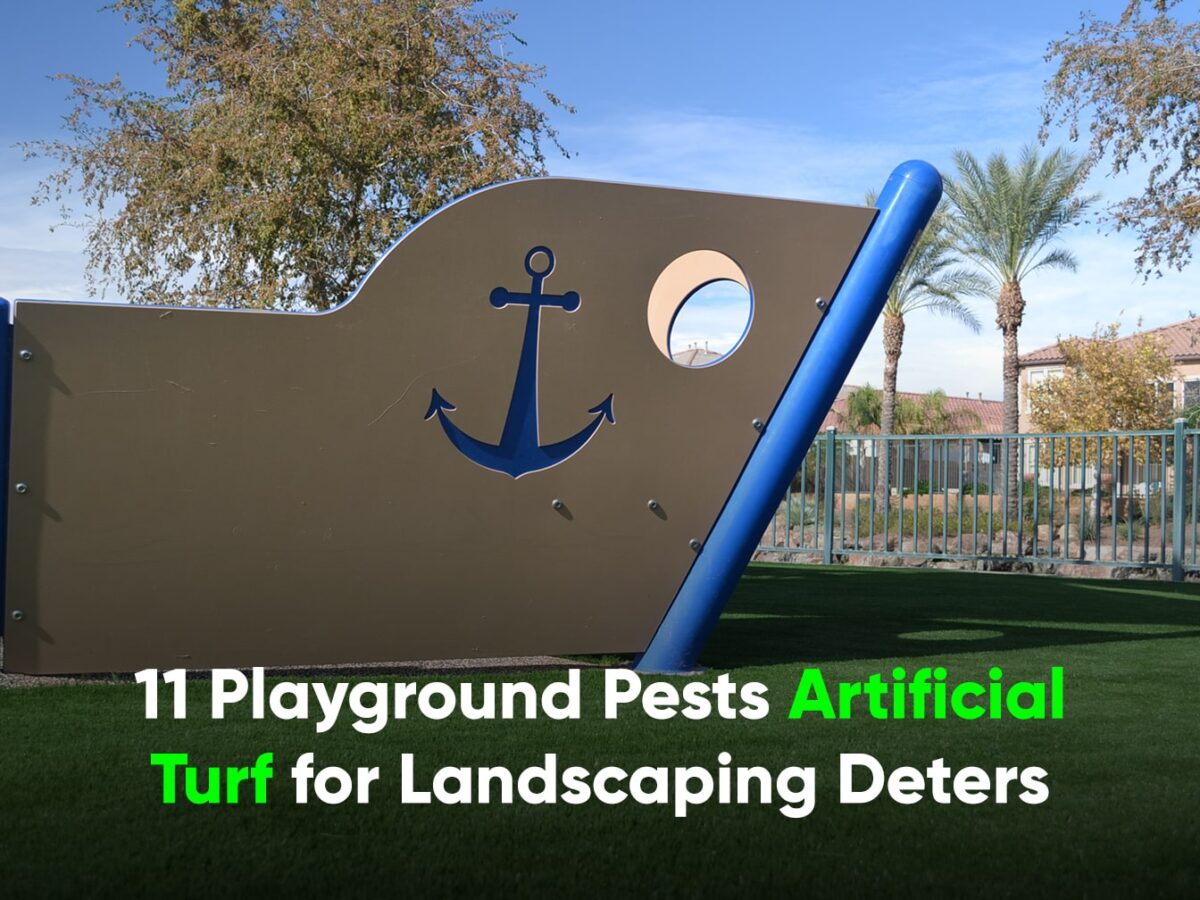- BACKYARD
- COMMERCIAL
- ENVIRONMENT
- FIELD TURF NEWS
- GOLF
- MAINTENANCE
- NEWS
- PETS
- POOL
- RESIDENTIAL
- TURF TIPS
Pest-Free Playgrounds: 11 Critters Artificial Turf for Landscaping Deters

Hearing laughter and seeing joy on a child’s face is priceless while they enjoy playground time. But, lurking in the grass could be pests that pose harm to precious playtime. The following pests love the warmth, protection and possible food sources that playgrounds with natural grass offer. Let’s look into how transitioning to artificial turf for landscaping can keep them at bay:
1. Ants
Ants are small creatures, but their effect can be significantly felt, especially by little feet that may disturb an anthill.
Species such as fire ants or pavement ants are common disruptors. Their bites are painful, can swell and might result in allergic reactions. Besides, the presence of anthills in play areas can lead to trip and fall accidents among children.
Artificial turf eliminates their prized grassy grounds and removes the soil, leaving ants with no choice but to set up their colonies elsewhere.
2. Fleas
Fleas are typically associated with pets, but they don’t mind calling your playground home either. The moist and warm environment offered by natural grass is perfect for their lifecycle. Itchy, red spots are the standard aftermath of a flea bite, a stark damper on a fun play day.
An artificial turf installation is non-organic and not conducive for flea habitation. Its superior drainage system leaves no room for the damp conditions fleas thrive in.
3. Ticks
Ticks are a serious concern for parents. These parasites latch on to humans and pets, potentially transmitting Lyme disease. Tall grasses around playsets and bordering playgrounds are their main hideouts.
By swapping natural grass for artificial turf, you’re robbing ticks of their hiding places. The turf’s short blades offer no shelter to ticks and its cleanliness discourages the presence of wild animals that might carry them.
4. Wasps
Parents have shuddered at the sight of wasp nests in the ground of a playground. A sting from a wasp can be sharp and very painful. Worse still, they can trigger serious allergic reactions in some children.
Artificial turf for landscaping prevents wasps from building nests. They simply have no access to the soil beneath, making the playground a safer space for children to play.
5. Chiggers
Chiggers frequent areas of overgrown grass and shrubby regions often found on the fringes of a playground. Their tiny size often leads to them going unnoticed until an intensely itchy bite reveals their presence.
Artificial turf’s clean and neat surface discourages chiggers from setting camp, sparing children the discomfort of chigger bites.
6. Ground Bees
Ground bees pose a dual problem in playgrounds: discomforting fears of bees for some children and serious health hazards if a child is allergic to bee stings. They love nesting in holes in the ground, a convenience natural lawns provide.
However, fake grass is a compact surface with no soil access, making it unsuitable for these bees.
7. Termites
Termites are primarily known as recyclers of wood and plant material. While they don’t pose a direct threat to children’s health, they can potentially endanger kids’ safety by gnawing away at wooden playground structures.
Artificial grass offers nothing for these pests to feed upon, which can prolong your playset’s life.
8. Mosquitoes
Stagnant water puddles that lurk within the uneven surfaces of natural grass are breeding grounds for mosquitoes. Beyond their itchy bites, they also pose the risk of transmitting West Nile Virus.
The excellent drainage system of artificial turf for landscaping eliminates standing water, creating an unfriendly environment for mosquito habitation.
9. Snails and Slugs
Snails and slugs might not bite or sting, but they can make playtime less enjoyable. These slimy creatures can quickly turn a playground into an unsightly and slimy mess, particularly after a rainfall.
By installing synthetic grass, you’ll remove their food source significantly, causing them to find new feeding grounds.
10. Spiders
Spiders thrive in secluded, unkempt grassy areas, which playgrounds can become without regular maintenance. While not all spiders are harmful, some, like black widows or brown recluses, can pose health risks to kids. Even non-harmful spiders can create unsightly webs in play equipment.
Artificial turf denies spiders the undergrowth and secluded spots that aid their survival, making the playground less habitable for them.
11. Rodents
While typically not the first pest that comes to mind when thinking about playgrounds, rodents can pose serious issues, from disease transmission threats to creating holes that can twist ankles. By installing artificial turf, you effectively eliminate the lush vegetation rodents love and seal off possible entry points to underground burrows.
Keep Play Spaces Pest-Free
Transitioning from natural grass to artificial turf can drastically decrease the number of potentially harmful pests, ensuring a safer and more enjoyable playground experience.
At Field Turf Landscape, our kid-friendly artificial turf solutions prioritize safety and cleanliness without compromising aesthetics. Start creating a safer, pest-free playground today. Contact us online or call us now at 866-352-4575 for a free consultation!


